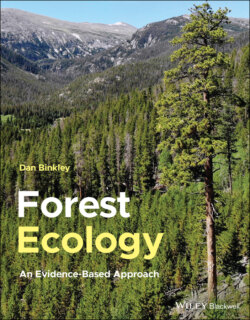Читать книгу Forest Ecology - Dan Binkley - Страница 42
Forests Use Very Large Amounts of Water
ОглавлениеEarth's atmosphere contains vast amounts of water, so much in fact that water is the most important greenhouse gas that keeps the planet from freezing. The rates of precipitation and evaporation are equally huge, and the atmosphere contains only enough water to supply Earth with 10 days of rain. About 90% of the evaporation that refills the air comes from open bodies of water, and most of the rest comes from water released from the insides of plants (mostly trees).
FIGURE 2.18 The average growth of wood in tropical forests around the world increases with increasing temperatures (top left), but declines as average annual temperature exceeds 25 °C. Temperature accounts for 23% of the observed variations in wood growth, so other factors (such as rainfall, species composition, forest age, etc.) lead to situations that are well above and below the average trend. The combined effect of temperature and rainfall accounts for 32% of the of the variation among studies, so the importance of high rainfall appears to be higher on warmer sites (top right,
Source: Based on of Taylor et al. 2017, Cleveland 2017).
Intensively managed plantations of eucalyptus grow much faster than unmanaged tropical forests (bottom figures, plantation in picture is six years old), with an even stronger apparent influence of temperature.
Source: Based on Binkley et al. 2020.
The units used for precipitation and evapotranspiration are typically one‐dimensional (mm). The one‐dimensional number can be converted to volume with multiplication by an area (such as 1 m2 or 1 ha). This approach also works for streamflow; dividing the total amount of water transported in a stream by the land area of the contributing watershed gives a one‐dimensional measure (mm) of streamflow.
The rain and snow that fall on forests do not accumulate from one year to the next; the water either reenters the atmosphere or runs off into groundwater and streams. Evaporation in forests may be divided into three categories. Some water sitting at the surface of the soil may evaporate, but this evaporation is a small part of the water budget. Much larger fluxes are evaporation of water from the outer surfaces of leaves (canopy interception), and water from within leaves (transpiration). The sum of these three vectors is total evapotranspiration. Forest soils can retain several cm of water, but high intensity storms (and melting of snow) can exceed the soil's capacity to store water, leading to recharge of ground water and streams. Forest evapotranspiration accounts for virtually all the water falling onto forests in dry regions (Figure 2.19). In some cases, riparian (streamside) forests use even more water than falls from the sky. Evapotranspiration in dry areas comes close to matching precipitation, leaving very little water for streamflow.
FIGURE 2.19 Forests occur in temperate regions where precipitation is typically greater than about 500 mm yr−1. Almost all the incoming precipitation is lost in evapotranspiration in drier regions (left), whereas streamflow accounts for almost as much water loss in wet regions. Conifers and broadleaves have similar evapotranspiration rates in dry areas, but conifers use more than broadleaves in wetter areas.
Source: Based on Ford et al. 2010.
A broadleaved forest in the Coweeta basin of North Carolina (Chapter 1) received 2160 mm of rain in a year (Ford et al. 2010). Evaporation from the soil surface was minimal, as the top part of the soil O horizon was often dry. The evaporation of water from the outsides of canopy leaf surfaces (interception) was 145 mm (7% of precipitation), and of course most of this happened during the growing season because of the low surface area of trees without leaves in winter. Transpiration loss of water from within leaves summed to 200 mm yr−1 (9% of precipitation), again mostly during the growing season. The sum of these losses (346 mm yr−1) accounted for 16% of precipitation, leaving 84% (1800 mm yr−1) to leave as streamflow.
Scientists at the Coweeta Hydrological Lab planted two entire watersheds with white pine trees to provide insights on water use by conifer forests versus native hardwood forests. The higher surface area of the pine needle canopy led to an interception loss of 280 mm yr−1 (13% of precipitation), and transpiration of 420 mm yr−1 (19% of precipitation), for a total evapotranspiration of 700 mm yr−1 (30% of precipitation) and streamflow of 1460 mm yr−1.
